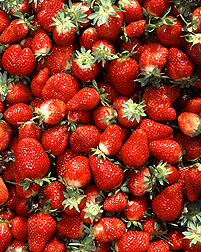This page has been archived and is being provided for reference purposes only. The page is no longer being updated, and therefore, links on the page may be invalid.
|
|
More Strawberries, More Antioxidant Absorption
By Rosalie Marion BlissAugust 21, 2008
Agricultural Research Service (ARS) scientists have assessed the human body's capacity for absorbing certain antioxidant compounds in strawberries, and have found that the absorption of one key beneficial plant chemical was not "maxed out" as volunteers ate more of this popular fruit. Foods high in antioxidants may be excellent sources of healthful compounds, and researchers are striving to learn more about their ability to be absorbed and utilized within the human body.
The study was conducted at the ARS Beltsville Human Nutrition Research Center (BHNRC) in Beltsville, Md., where scientists have pioneered methods for identifying and measuring various plant compounds in fruits and vegetables. Physiologist Janet Novotny, with the BHNRC's Food Components and Health Laboratory, led the study, which was published recently in the Journal of Nutrition.
Marketed year-round, strawberries are the fifth most consumed fresh fruit in the United States, and consumption more than doubled in the past decade, according to experts. Strawberry's antioxidants come in the form of both long-established vitamins and newly defined plant chemicals. Berries are particularly well endowed with a series of compounds called anthocyanins--the source of the berries' blue, purple and red pigments.
In the study, 12 volunteers consumed three different serving sizes of strawberries during three separate treatment periods. Each two-day meal treatment included either 3.5 ounces, 7 ounces, or 14 ounces of blended strawberries, along with a full diet of carefully controlled foods. Each treatment period was separated by a one-week break.
The study showed that the human body is capable of assimilating more anthocyanin pigments as intakes increase. The results will help nutrition scientists evaluate the healthful properties of individual anthocyanins and aid plant breeders in developing varieties with optimal anthocyanin content.
ARS is a scientific research agency of the U.S. Department of Agriculture.

